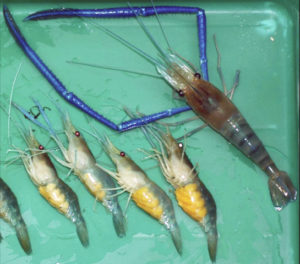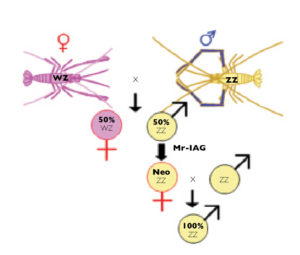Sex-reversal technology does not use hormones or chemicals, does not produce genetically modified prawns

Editor’s Note: The author received the Novus Global Aquaculture Innovation Award during GOAL 2013. This article reflects his award-winning work with all-male populations of freshwater shrimp. The technology is licensed to Tiran Shipping Ltd.
Commercial production of freshwater prawns has been the subject of research and commercial enterprise in many countries for several decades. This species is native to the tropical Indo-Pacific region of the world and is an economically important crop in China, India, Vietnam and many other Asian countries. It has high demand as a food item and an export product.
Its relatively limited wild catch has resulted in a gradual increase in traditional culture of the prawns. The global market for freshwater prawns was growing annually until 2009. China, India and Vietnam together annually produced more than 200,000 metric tons (MT) of prawns with a value of $2.4 billion. To sustain growth of this sector, genetic, husbandry and biotechnological improvements are needed, including attempts to use approaches such as monosex culture.
Monosex culture

In many crustacean species, a sexual bimodal growth pattern is exhibited in which females grow larger than males of the species or vice versa. In two of the most economically important penaeid shrimps, Litopenaeus vannamei and Penaeus monodon, females grow larger than males. However, in cultured species such as the Australian red-claw crayfish (Cherax quadricarinatus) males grow faster and reach higher weights than females. This is also the case for the giant freshwater prawn Macrobrachium rosenbergii) as males reach market size faster than the females.
Differences in growth rate, alimentary needs and behavioral patterns between males and females dictate the need to establish management procedures specifically adjusted to one sex or the other. Moreover, since a monosex culture population is inherently non-breeding, energy is focused on growth, and unwanted breeding is prevented – both in the pond and as an unwanted environmental impact. Reproduction can be carried out in such systems under separate, controlled conditions.
The monosex strategy has become a common practice in fish culture, and attempts have been made to apply it to crustacean culture. In a small-scale experiment conducted as early as 1986 in Israel, hand segregating M. rosenbergii monosex populations in hapa nets resulted in significantly higher yields when all-male populations were cultured.
More recently, an economic analysis of all-male culture in India showed an income increase of about 60 percent over mixed and all-female populations, taking into account expenses caused by labor-intensive hand segregation and related costs. Alternatively, all-female culture has been suggested as the choice for super-intensive culture of small M. rosenbergii prawns at high densities.
Microsurgical sex reversal
In M. rosenbergii, fully functional sex reversal can be achieved by microsurgical manipulation of the androgenic gland in early postlarval males. Although such manipulation dates back more than half a century, a biotechnological approach only recently devised for the generation of all-male populations involves the microsurgical removal of the androgenic gland from juvenile males. The microsurgery biotechnology for all-male monosex culture of prawns has been used in India, Thailand and Vietnam.
The author’s research found that sex-reversed animals or “neo-females” are capable of mating with normal males to produce all-male offspring. Since M. rosenbergii males are the homogametic sex, bearing two homologous sex chromosomes (ZZ), sex-reversed males produce 100 percent male progeny.
Gene silencing
Recently, a more advanced RNA interference (RNAi)-based biotechnology was developed in the author’s laboratory at the National Institute of Biotechnology at Ben Gurion University (BGU) of the Negev in Israel. It is based on the recent finding of a patented new gene encoding an insulin-like androgenic gland hormone from M. rosenbergii termed Mr-IAG.
It was found that silencing this gene through RNAi at an early postlarval stage could cause complete sex reversal of a male into a functional neo-female. The technology includes the application of temporal RNAi in males of the BGU line of M. rosenbergii prawns. Through the use of specific molecular sex markers, the identified males are transformed through temporal RNAi into neo-females. The BGU neo-females are shipped, grown and bred with selected local lines of males at each locality to produce all-male populations.
Perspectives
The sex-reversal technology does not use hormones or chemicals, and it does not produce genetically modified prawns. The intervention is temporal, occurring during a short period at the early stages of the neo-females. The silencing agent is a naturally occurring sequence of RNA that degrades in a few days. It is not transmissible to future generations, and the manipulation is limited to the broodstock, with no manipulation necessary in grow-out populations.
This approach may be of tremendous application in the aquaculture industry. Moreover, it could also form part of a sustainable solution for the management of invasive and/or pest crustacean species, where the production of non-reproducing male or female populations is sought. The silencing agent is not transmissible to future generations, and the manipulation is limited to the broodstock, with no manipulation necessary in grow-out populations.
(Editor’s Note: This article was originally published in the November/December 2013 print edition of the Global Aquaculture Advocate.)
Author
-
Amir Sagi, Ph.D.
Professor
Lily and Sidney Oelbaum Chair in Applied Biochemistry
Department of Life Sciences
National Institute of Biotechnology
Ben Gurion University of the Negev
P. O. Box 653
Beer Sheva 84105, Israel[108,105,46,99,97,46,117,103,98,64,97,105,103,97,115]
Tagged With
Related Posts

Intelligence
Bangladesh’s tilapia aquaculture industry shows resilience
Tilapia aquaculture in Bangladesh has developed significantly since 1999, based on the Genetically Improved Farmed Tilapia (GIFT) strain of Nile tilapia (Oreochromis niloticus) introduced from Malaysia and on the significant genetic improvement research work by the Bangladesh Fisheries Research Institute (BFRI).

Health & Welfare
Market test: Farm-grown freshwater prawns
A small test market at a high-end grocery store near Washington, D.C., USA, showed that farm-grown freshwater prawns would sell to high-income consumers who had not previously tried the product.

Health & Welfare
Double-stranded RNA against WSSV genes provides antiviral protection in shrimp
Silencing genes in white spot syndrome virus (WSSV) with critical roles in replication could provide a strong antiviral effect and thus reduce shrimp mortality. The authors therefore established a study to evaluate the antiviral efficacy of double-stranded (ds)RNA against non-structural WSSV genes.

Health & Welfare
Potential of YY male tilapia technology
YY male tilapia technology, based on the genetic manipulation of sex, provides a robust, reliable method of achieving male fish. It avoids the use of hormones and maintains strain purity in genetically normal males.


